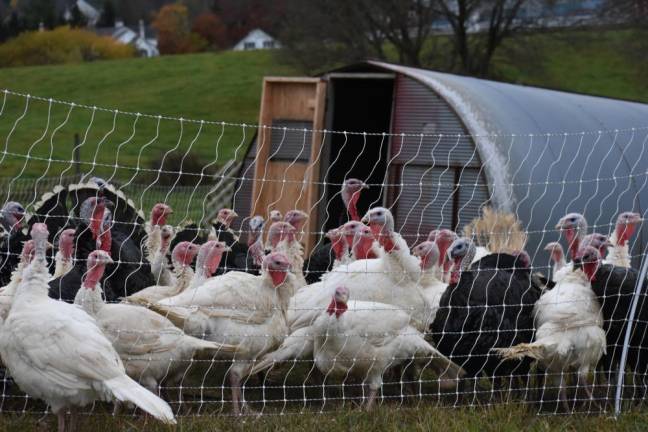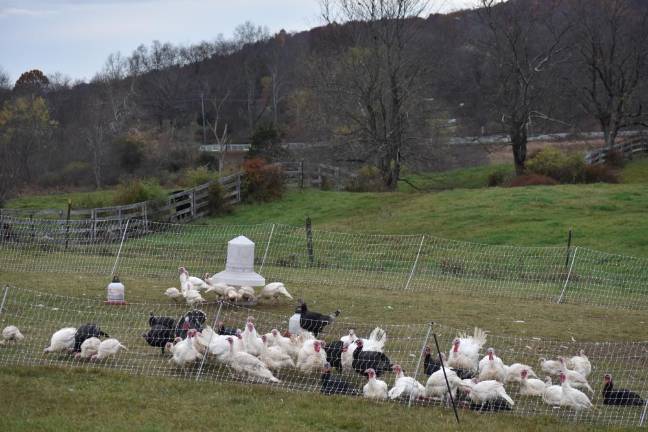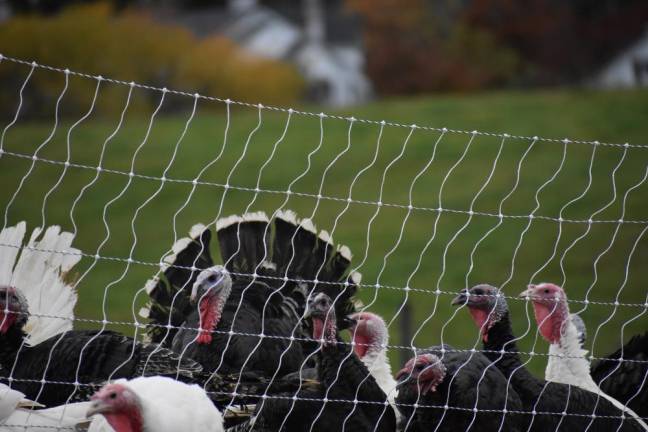Smaller turkeys in demand for downsized Thanksgivings
Holiday. Local farmers are relieved to be selling out, but as one of them observed, “I can’t put our turkeys on Weight Watchers.”



Turkey farmers are struggling as much as everyone else with their predictions during our pandemic era.
“We were concerned going into the fall that we wouldn’t have that much demand because we thought people would not be hosting Thanksgiving this year,” said Samantha Naftal, owner of Flatbrook Farm in Sandyston, N.J., which raises 60 to 70 turkeys a year. “But as it turns out, demand is just fine. People are hosting, they’re just asking for smaller birds.”
The size requested has dropped from an average of about 18 pounds to between 12 and 14 pounds, she said.
Customers have been putting in pre-orders for smaller turkeys at Prime Time Meats in Milford, Pa., as well. “Typically, people do like an 18- to 20-pound turkey, and now it’s more toward that 10- to 12-pound weight bracket,” said Thomas Seltzer, an employee. “So far this year it seems like people have been ordering smaller turkeys because they don’t have as many people coming over.”
But, despite conjecture that home chefs would forego a turkey altogether this bizarre Thanksgiving season, local farmers are relieved to discover that people still want a turkey on the table. And they are willing to pay a premium for a sustainably raised bird. Pre-orders for pastured turkeys, along with a $20 commitment, have been coming in at Flatbrook Farm, where they are on pace to be sold out as usual.
“All of our regular customers are coming back,” said Naftal. “Poultry aside, Thanksgiving day aside, the theme this year has been people seeking to buy locally, and to buy from a shorter food supply chain. Plus, they didn’t want to go to the grocery store. They wanted products that were touched less, handled less.”
Farm manager Bob Campbell meets me at Flatbrook Farm on a utility vehicle, leading me past stately red barns and neat white fences to the turkey flock. The birds are out on a grassy hillside, surrounded by movable electric fencing, next to a pasture of grazing cows. As part of a beyond-organic rotational grazing system, the turkey hut is moved every other day, and their electric fencing moved weekly to fresh pasture, following in the path of the cows. Campbell and another farmer will do the slaughtering on-site on the Monday and Tuesday before Thanksgiving.
It looks blissfully bucolic, until Campbell shows me his arms, covered in decades of scars and a fresh scab from a turkey bite that had finally stopped bleeding after two days. “A 25-pound bird that doesn’t want to get caught is going to fight you,” he said resignedly. “Thanksgiving can’t come soon enough.” That day will find him enjoying the fruits of his labor on his own table. “It’s way different from your standard Butterball, which I grew up eating,” he said. “Fresh is as big a part of it as anything else. When you buy a frozen Butterball, it could have been frozen six months ago.”
Some of these turkeys will be on the smaller side, but only by chance. They ordered a round of replacement poults, or baby turkeys, after some in the first flock didn’t make it – “which happens, since we don’t use antibiotics or anything like that,” said Naftal. That second batch of birds, which arrived in early July, is a month younger than the first. That will work out well when filling those requests for smaller birds.
Aside from that, “we aren’t doing anything different,” said Naftal. “It’s all a matter of our customers being understanding and flexible, and they are, because they know we’re pasture raising and it’s variable. To some extent they kind of enjoy that’s part of the process, and what we’re doing is not this kind of strict science. Whatever they weigh Thanksgiving week, that’s what it is. Then we just have to temper their expectations. Please be flexible if the birds come in a little over or a little under.”
Getting smaller, gradually
Even before the pandemic, the turkey at the center of the Thanksgiving table had been trending smaller. “As for people wanting smaller turkeys, that has been the trend for the last few years, because I guess families aren’t as big,” said John Hoffman of Hoffman Hatchery in Lykens, Pa., which supplies Flatbrook Farm. “The growers, I guess, get them later, like at the end of July or beginning of August. That’s when most of the growers want them. I’d say for the last few years it seems to be getting later and later because they don’t want that big of a turkey.”
This year was no different than the last few for Hoffman Hatchery. And next year won’t be, either. “We’re just going to put in the normal amounts that we did before – what we can sell,” Hoffman said. “We’re not going to set up for a lot more because we don’t want to have baby turkeys on hand. We’ve been at this for a long time and we know about what it takes.” Hoffman’s mother started the hatchery. “We’ve been doing it for 72 years,” he said.
In the face of countless unknowns, suppliers are doing their best to hold steady. Bobby Mateszewski, owner of Quaker Creek Store in Pine Island, N.Y., put in his regular order for Thanksgiving turkeys from his suppliers. He won’t start accepting orders from his own customers until Nov. 1, and until then he’ll have no idea whether or not he over-ordered. “We have to pre-book in September, so we take a major crapshoot every year,” he said. Three or four years ago, there were bad hail storms in Pennsylvania and his turkey farmers came up short. This year, the weather’s been good, but will the demand be there?
“I don’t know what to think,” he said. “I want to commit to things. There’s so much ambiguity, but somehow or another we’ll come through.” If worse comes to worst and the turkeys don’t sell, “we do a lot of prepared foods,” he said, and they can use leftover birds that way.
‘Super individual’ turkeys
At Gray Family Farm, in New Windsor, N.Y., the first batch of turkeys was headed to the slaughterhouse the last Friday of October, a couple weeks ahead of the typical schedule. “This week we have to pull the ones that are going to be going: mostly small, but I’ll throw a few larger ones just so that I’ll have a little variety,” said farm manager Jennifer Migdal. “Out of 150 birds, you have to pick out 40. It’s like herding cats.”
The expedited timeline is mostly a result of the mild autumn that’s allowed the turkeys to plump up fast, she said. Though she’d been expecting a run on smaller turkeys, Migdal hasn’t actually seen it from her customers – at least not yet. Then again, it’s still early. “People’s schedules change and family numbers, as far as how many people they’re having,” she said. “I’m going to let them choose if I can.”
For first-time chefs, the farm’s website has a formula to determine what size turkey you need: add six to eight pounds to the number of people eating. So if you’re feeding four people, you’ll want a 10- to 12-pound bird.
They cover their bases at Gray Family Farm by raising turkeys in three age groups of 50 poults apiece. That way, said Migdal, “you’re setting yourself up for a variety of sizes.” But once the gears are in motion, nature runs the show. Customers like to think they can request a certain size, and voila, that’s what they’re going to get. But it really has nothing to do with the farmer, said Migdal, and everything to do with the weather.
“We have no control over Mother Nature, so you kind of get what you get and you don’t get upset,” she said. “We’ve had some years where it’s been so bitterly cold come October, and they are ravenous animals, they will eat and eat and eat and won’t gain an ounce because they’re fighting to stay warm. When you’re dealing with pasture-raised, those are the things you have to deal with. Like any other breathing thing, you’re going to burn more calories when you’re fighting to stay warm outside.”
On top of that, turkeys are “all super individual,” she said. Out in the uncontrolled pasture environment, two birds in the same flock can weigh in at 12 pounds and 24 pounds, a 100 percent variation. “Some of the younger ones might get bigger than the older ones,” she said, “because they’re pigs and they shoe everyone else away” from the food.
There are two kinds of customers, said Migdal: those who “just want to know the animal was cared for and had a good life,” and those who, through no fault of their own, grew up thinking that turkeys come from a grocery bin, and eggs come from a carton. With the latter, there’s an educational component of a farmer’s job, which can be accomplished with a light touch. “We do always joke that I can’t put our turkeys on Weight Watchers when people say, ‘Well that’s too big, I want my turkey smaller,’” she said.
Gray Family Farm is on pace to be sold out of turkeys about a week ahead of usual. Migdal likes to keep aside a buffer of 10 to 15 turkeys that aren’t spoken for, as an insurance policy against the vagaries of nature. A weasel, for instance, had just gotten into the chicken coop and killed 10 hens. “Turkeys are a little hardier, but you just never know. I like to make sure that everyone who ordered a turkey gets one.” If all goes well, those buffer turkeys will go to people on the waitlist, and to the customers who show up last-minute looking for a smaller bird. “They don’t want to throw their hat into the ring until they know the weight, because it’s not cheap,” she said. “I get that.”
Notwithstanding the recession, the prospect of spending more on a choice bird is not keeping customers away. Maybe since people aren’t traveling, Migdal conjectured, they feel they can spend a little more on a turkey. It’s not just any turkey, of course. A testimonial on the farm’s website attests to its “shatteringly crisp skin. Unctuous flavour. Moist throughout. We ate every little bit, and then pulled the meat off the bones, made stock, and followed up two days later with turkey carnitas ramen.”
Clean meat is in demand
Samer Saleh, owner of Halal Pastures in Rock Tavern, N.Y., raises 400 to 600 turkeys a year, working with a farm in Syracuse. Like his own family, many of his predominantly Muslim customers don’t formally celebrate Thanksgiving. But they may observe it in a more casual way, one that often involves turkey. “What we’ve seen is a lot of families just use it as an opportunity to get together and share a meal,” said Saleh. Halal Pastures offers a 16.5-pound turkey for $140, about six times the cost of a frozen Butterball. “Thank God every year has been sold out, and then we had more demand,” he said.
“People are looking for these soy-free, wholesome, higher quality items,” said Saleh. His turkeys eat an organic mix of grains like corn and lentils, some of which are grown on the farm where the birds are raised. Each September, Saleh slaughters the turkeys according to Muslim law. He works with a crew at a certified organic slaughterhouse, but crucially, it is Saleh himself who holds each animal’s head in his hand, looks it in the eye, and utters a prayer before making one cut across the neck with a very sharp knife.
Because his meat is frozen and shipped all over the country, Saleh operates on a more relaxed timeline. If his turkey doesn’t sell by November, “it will sell in December and January, we’re not worried about it,” he said. A little more than half the turkey gets turned into parts – breasts, drums, wings, tenders – which are offered on the Halal Pastures website alongside grass-fed filet mignon, leg of lamb, and beef kabob.
“Most of us our customers tend to be families, so they do tend to order the larger size,” he said. But he’s just began offering a smaller size, too, since a few dozen of his turkeys ended up on the light side. “I’m sure 30 or 40 birds at 12 pounds will probably fly off the shelf.”
“A 25-pound bird that doesn’t want to get caught is going to fight you. Thanksgiving can’t come soon enough.” —Bob Campbell, Flatbrook Farm